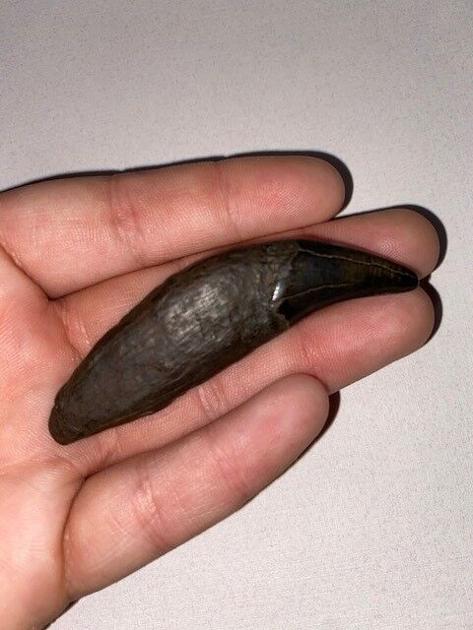MONCKS CORNER – A diver found what scientists believe to be the fossilized tooth of the largest prehistoric bear roaming North America, but at the bottom of the Cooper River.
When Eric Proulx, an amateur fossil hunter, found the 3-inch tooth of a giant short-faced bear (Arctodus simus) on March 20, while diving with Cooper River Dive Charters, he didn’t think it was a big deal.

After all, Proulx had found many fossils over the years while diving into the murky waters of lower Berkeley County. Last year, he found a 2.5-meter woolly mammoth tusk; the jaw of a rare prehistoric cat; and dozens of shark teeth.
“Honestly, I had no idea what it was,” said Proulx, who started combining his passion for fossils and diving in 2018. “
Honestly, I wasn’t so excited about it at first, “he added.” I thought it was a whale or a dolphin tooth. It’s crazy because you never know what you’re going to find out there. “

Eric Proulx of Fort Mill found a seven-centimeter tooth of a giant short-faced bear (Arctodus simus) in the Cooper River. Eric Proulx / provided.
Proulx took several photos of the discovery and posted them on the social media page of the Palmetto Paleontological Society, an online community of professional and amateur paleontologists and fossil hunters.
College of Charleston paleontologist Robert Boessenecker, an expert on prehistoric whales and dolphins, believed it was the tooth of a prehistoric land mammal. Another paleontologist speculated to be a tooth of an American lion (Panthera atrox), which was found mainly in the western United States.
“The teeth of bears and cats can be very similar,” said Boessenecker. “It is often difficult to tell the difference, but I was pretty sure it was a large, carnivorous mammal.”

Richard Hulbert, the Florida Museum’s vertebrate paleontology collection manager, later determined that the tooth came from a giant short-faced bear.
“I can say with 98 percent certainty that it is a bear tooth and most likely a giant short-faced bear,” said Hulbert, who has studied prehistoric mammals for the past four decades. “It is a very good specimen. These bears are bigger than any bear that lives today. “

The giant short-faced bear (Arctodus simus) first appeared about 800,000 years ago in the United States. Eric Proulx / provided.
Giant bears first appeared about 800,000 years ago in the United States during the Pleistocene Period, and soon spread to Canada. The bear is believed to have weighed an average of 2,000 pounds and was nearly two meters tall at the shoulder. Entirely designed, these huge bears could reach up to 3.6 meters.
The animals were extinct about 11,000 years ago.
“These bears are the largest carnivores that have ever existed in North America,” said Hulbert.
The fast currents of the Cooper River make it an excellent hunting ground for fossils and artifacts.
“When they open the dam (Pinoplois), it cleans the mud and tends to erode faster than in other rivers,” said Proulx.
On that cold March day, Proulx said he found the tooth at the bottom of the river about 15 meters from the water. The water temperature that day was around 58 degrees. Proulx uses a strong video light on the top of his helmet to help him see in the murky waters.
“I was wearing a wetsuit and it was still very cold,” said Proulx. “The visibility was about thirty centimeters. I just saw something in the background and picked it up. “
In the past, Proulx found 10,000-year-old pottery and glass bottles in the 1700s at Cooper.
The electrical engineer said he plans to donate the fossil to the South Carolina State Museum’s natural history collection.
To reach Andrew Miller at 843-937-5599. Follow him on Twitter @APMILLER_PandC
